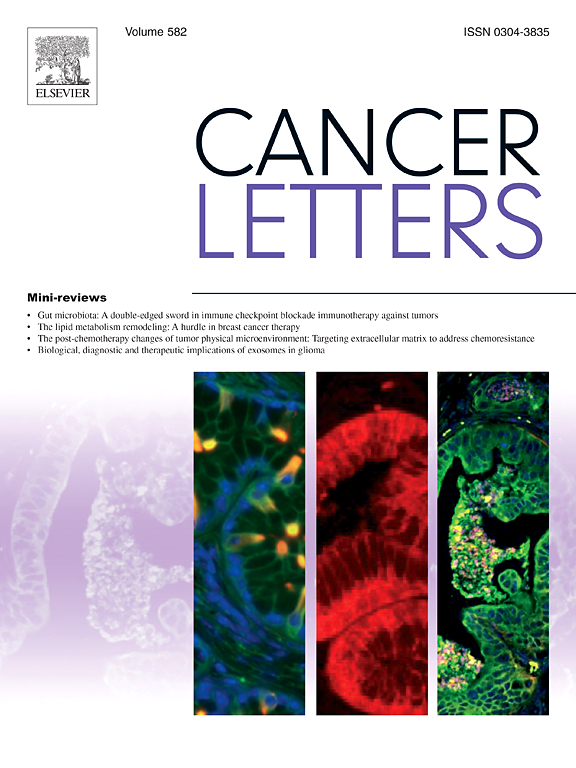UBE2C通过APC/ ccdh1介导的WDR76降解,通过KRAS稳定促进胰腺肿瘤发生。
IF 10.1
1区 医学
Q1 ONCOLOGY
引用次数: 0
摘要
基于生物信息学的关联研究显示,E2泛素结合酶UBE2C与胰腺癌和患者生存呈正相关。然而,UBE2C是否以及如何在胰腺肿瘤发生中起因果作用仍然难以捉摸。在这里,我们报道UBE2C在这一过程中起着启动子的作用。具体而言,UBE2C mRNA和蛋白水平在胰腺导管腺癌(PDAC)中均上调,其水平与不良预后显著相关。在细胞培养模型中,UBE2C敲低抑制胰腺癌细胞的增殖、存活、迁移和侵袭,而其过表达则促进这些过程。在体内小鼠模型中,Ube2c缺失抑制由KrasG12D和KrasG12D驱动的胰腺肿瘤发生和转移;P53 - / -,从而显著延长小鼠的寿命。机制上,WDR76与CUL1 E3连接酶偶联,而不是与CUL4偶联,促进野生型和突变型KRAS的降解,从而破坏KRAS的稳定。相比之下,UBE2C与APC/CCDH1 E3连接酶以KEN-box基序依赖的方式降解WDR76,导致KRAS积累和MAPK信号通路的激活,从而驱动胰腺肿瘤的发生。值得注意的是,KRASG12D驱动小鼠胰腺组织中WDR76水平随着PDAC的进展而降低,而KRASG12D和UBE2C水平升高。此外,通过腺相关病毒(AAV)注入胰管同时敲低WDR76,完全挽救了由Ube2c缺失引起的RAS/ERK失活和PDAC抑制,证明了Ube2c -WDR76轴的因果作用。总的来说,这些发现表明UBE2C-WDR76轴可能是治疗kras驱动的胰腺癌的一个有希望的治疗靶点。本文章由计算机程序翻译,如有差异,请以英文原文为准。
UBE2C promotes pancreatic tumorigenesis by KRAS stabilization via APC/CCDH1-mediated WDR76 degradation
Bioinformatics-based association study revealed a strong positive correlation between UBE2C, an E2 ubiquitin-conjugating enzyme, and pancreatic cancer and patient survival. However, whether and how UBE2C plays a causal role in pancreatic tumorigenesis remains elusive. Here, we report that UBE2C functions as a promoter in this process. Specifically, both the mRNA and protein levels of UBE2C are upregulated in pancreatic ductal adenocarcinoma (PDAC), and its levels significantly correlate with poor prognosis. In cell culture models, UBE2C knockdown inhibits the proliferation, survival, migration, and invasion of pancreatic cancer cells, while its overexpression promotes these processes. In in vivo mouse models, Ube2c deletion suppresses pancreatic tumorigenesis and metastasis, driven by KrasG12D and KrasG12D;p53−/−, respectively, thereby significantly extending the lifespan of the mice. Mechanistically, WDR76 couples with CUL1 E3 ligase, rather than CUL4, to promote the degradation of both wild-type and mutant KRAS, thus destabilizing KRAS. In contrast, UBE2C cooperates with APC/CCDH1 E3 ligase to degrade WDR76 in a KEN-box motif-dependent manner, leading to KRAS accumulation and activation of the MAPK signaling pathway, which drives pancreatic tumorigenesis. Notably, WDR76 levels in pancreatic tissues of KrasG12D-driven mice decrease as PDAC progresses, while the levels of KRASG12D and UBE2C increase. Furthermore, simultaneous WDR76 knockdown via adeno-associated virus (AAV) injection into the pancreatic duct fully rescues RAS/ERK inactivation and PDAC suppression caused by Ube2c deletion, demonstrating a causal role of the UBE2C-WDR76 axis. Collectively, these findings suggest that the UBE2C-WDR76 axis may represent a promising therapeutic target for the treatment of KRAS-driven pancreatic cancer.
求助全文
通过发布文献求助,成功后即可免费获取论文全文。
去求助
来源期刊

Cancer letters
医学-肿瘤学
CiteScore
17.70
自引率
2.10%
发文量
427
审稿时长
15 days
期刊介绍:
Cancer Letters is a reputable international journal that serves as a platform for significant and original contributions in cancer research. The journal welcomes both full-length articles and Mini Reviews in the wide-ranging field of basic and translational oncology. Furthermore, it frequently presents Special Issues that shed light on current and topical areas in cancer research.
Cancer Letters is highly interested in various fundamental aspects that can cater to a diverse readership. These areas include the molecular genetics and cell biology of cancer, radiation biology, molecular pathology, hormones and cancer, viral oncology, metastasis, and chemoprevention. The journal actively focuses on experimental therapeutics, particularly the advancement of targeted therapies for personalized cancer medicine, such as metronomic chemotherapy.
By publishing groundbreaking research and promoting advancements in cancer treatments, Cancer Letters aims to actively contribute to the fight against cancer and the improvement of patient outcomes.
 求助内容:
求助内容: 应助结果提醒方式:
应助结果提醒方式:


